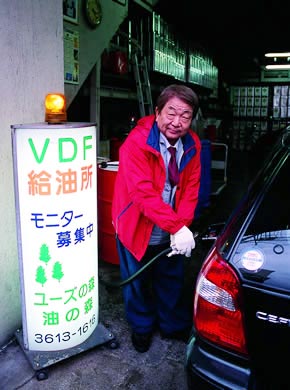| Web Japan > NIPPONIA No.28 > Special Feature* |
|
|
|
NIPPONIA No.28 March 15, 2004
|
|
Special Feature*
Fun with renewable energy
The world's smallest wind turbine

The main reason why five young people launched a small venture called North Power Co., Ltd. was because "we wanted people to enjoy using renewable energy." The company combines the advantages of solar and wind power generation, designing and constructing systems that meet the electric power demands of customers.
The company offers a unique product as well—the world's smallest wind turbine, the NP103. The turbine uses a bicycle light dynamo.
"Our idea was to make a beginner's wind turbine that everyone will feel they understand well, so we decided it was best to use the ever-familiar bicycle light dynamo. And we wanted buyers to have a hands-on experience by assembling the system themselves," says Ushijima Masaki, the developer. The do-it-yourself kit helps people understand the structural aspects of wind turbines. Owners can adjust the wing angle to get maximum output from weak and strong winds.
Wing length is 20 cm, electrical output 3 watts. That is only enough energy for one tiny light bulb. Even so, users say that when the wind blows and the light comes on, they enjoy having their own wind turbine.
A replacement for fossil fuel
Running cars on waste vegetable oil
The Japanese like tempura (seafood and vegetables deep-fried in a batter) and other deep-fried food. In Japan, cooks discard about 400,000 tons of cooking oil every year. If the oil is thrown out, it can pollute the environment.
Unwanted oil is now being transformed into a fuel for motor vehicles. One enterprise doing this is the Someya Shoten Group of Sumida, Tokyo. The company president, Someya Takeo, explains, "Before, used tempura oil from restaurants was collected and recycled into things like animal feed, fertilizer and soap. But cheaper imported cooking oil eventually began replacing it. Just when I was wondering how else we could use tempura oil, I heard about vehicles with diesel motors running on vegetable oil. I thought, maybe we could do the same with used tempura oil."
After a period of research, in 1993 the company succeeded in developing VDF (Vegetable Diesel Fuel), which is based mainly on waste cooking oil. VDF gives off no sulfur oxides and less than one third of the black smoke emitted by diesel fuel.
The oil collection method is unique—if you send the depot used oil in plastic bottles ten times, you will be given ownership of 3.3 square meters of forest in Tadami-cho, Fukushima Prefecture. This system recycles waste cooking oil, recruits forest owners, protects woodland, and cuts down on CO2 emissions.
|
|
||||||||
|
||||||||
|

